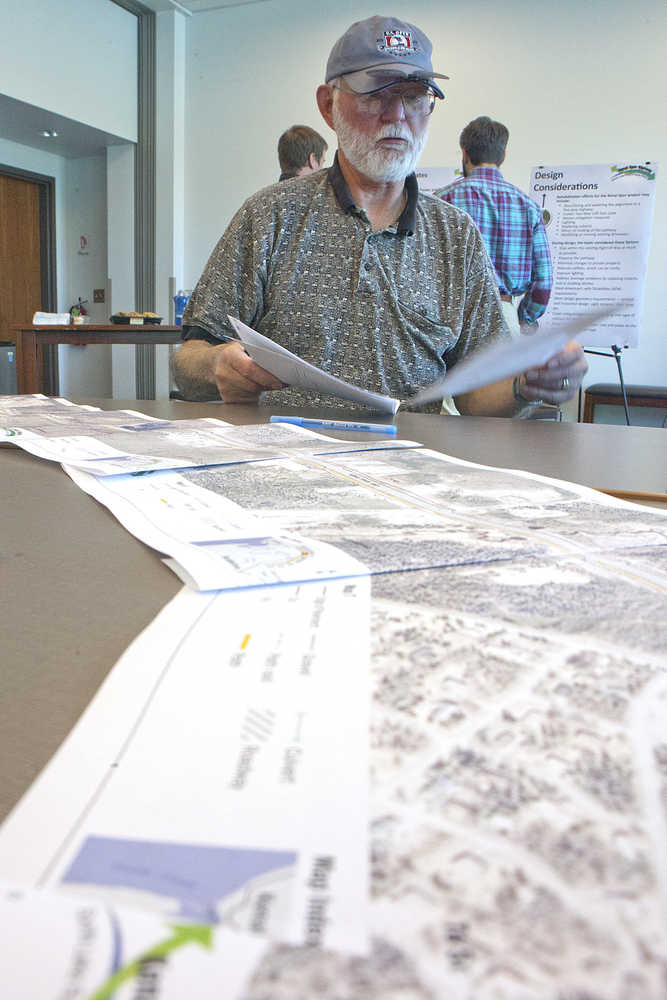A project designed to improve a heavily-used highway corridor between Kenai and Soldotna is moving forward, despite missing more than half of the estimated $40 million needed to finish it.
Alaska Department of Transportation, DOT, project managers are asking for public feedback on which parts of the plan to upgrade a nearly 6 mile segment of the Kenai Spur Highway should be built first.
While the particulars of a plan to improve the corridor — which stretches from Sports Lake Road near the Soldotna end, to Swires Road near the Kenai end — have been up for debate for nearly three years, project managers have decided to widen the highway to five lanes.
Few other construction details have been solidified, said DOT Project Manager Sean Holland.
“We’re going to design that whole stretch to 75 percent and then we’ll try to focus in on what we can build with the money we have,” he said.
It is likely that the construction, which is set to begin in 2017, would start in Kenai and move toward Soldotna until the project runs out of funding, he said.
“That’s not set in stone,” he said.
It would be easier to start the project in Kenai and build toward Soldotna because there are fewer right-of-way issues, he said.
The project could spend as much as $2.8 million on right-of-way purchases from private landowners, according to DOT data, though Holland said that he felt that estimate was high.
As project managers work on a design, which is scheduled to be released to the public in September, there are a suite of problems to be addressed. Engineers have said that the current two-lane highway is not wide enough to handle the volume of traffic it sees each year.
During a 2014 meeting, DOT Engineer Carol Roadifer said the road sees a volume of 11,500 vehicles a day and over the next 20 years is expected to see up to 16,500 vehicles per day.
It also has higher-than-average crash rates. A 2005-2009 study of the road counted 169 reported crashes along the highway — a number that could be as much as 50 percent above the national average for comparable roadways, Holland said. The majority of the accidents reported on the highway were from vehicles colliding with moose.
Engineers have presented options to widen the highway, install lights and clear trees from the roadside. Each is estimated to cost millions to implement.
Several people who attended an open house meeting at the Soldotna library on Thursday spent time weighing in on the project’s design either via written comments or using iPads provided by the project managers to fill out a survey.
More than 50 people attended two recent Soldotna-area meetings and Holland said many left their thoughts on the project either through weighing in with DOT staff at the meetings, or by filling out the DOT survey which should be available through September.
Cliff Heus, of Kenai, did both.
Heus said he lives near the intersection of the highway and Strawberry Road. Strawberry Road bisects the highway with one end running west toward the Kenai River and the other east toward the community of Ridgeway.
However, the two halves of Strawberry road do not intersect with the highway evenly and drivers making left-hand turns from either direction must navigate around each other and oncoming traffic to reach the section of the road onto which they wish to turn.
While the number of crashes reported at that specific intersection are fairly low, Holland said, it would be better designed as a T-shaped intersection. He said project managers were looking for site-specific feedback, from people like Heus.
“We’re looking for that kind of stuff, even if there’s not a lot of action in a specific area. If there are some near misses that are being reported, we want to know that. We’re also looking for drainage and icing issues. We don’t drive that road every day,” he said, “so we’re looking for local knowledge and things like that.”
To comment, visit kenaispurrehab.com and take the project survey located and top portion of the site.
Reach Rashah McChesney at rashah.mcchesney@peninsulaclarion.com or follow her on Twitter @litmuslens.

